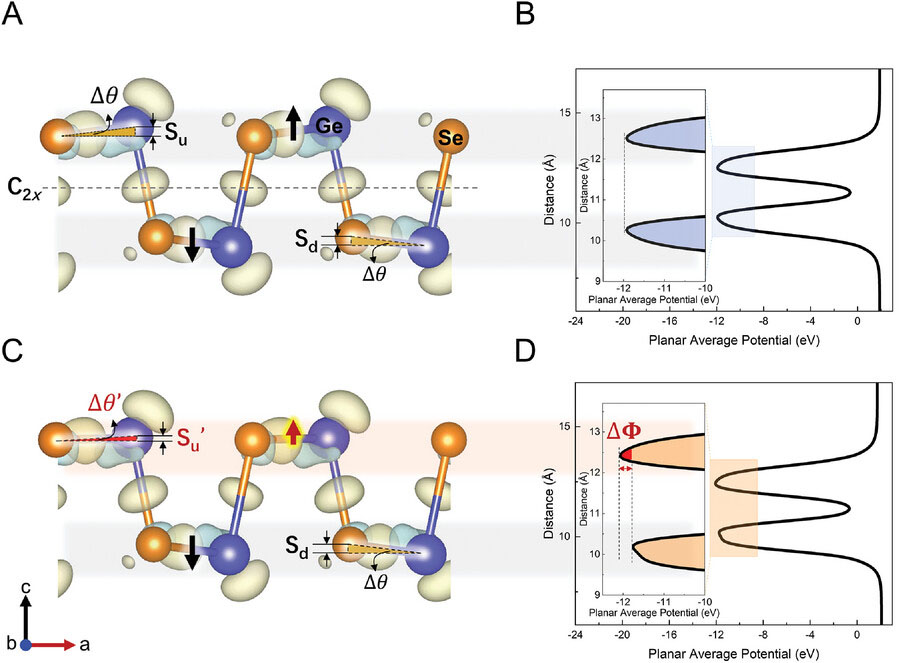| Jun 04, 2024 |
|
|
|
(Nanowerk Spotlight) In their pursuit of device miniaturization, researchers are exploring the untapped potential of two-dimensional materials. These atomically thin crystals, with their unique electronic and optical properties, have emerged as promising candidates for the next generation of ultra-compact, high-performance electronic devices. However, despite the rapid progress in the field, inducing and controlling polarization in these materials has remained a persistent challenge.
|
|
Ferroelectric materials, which exhibit a switchable electric polarization, have long been of interest for their potential applications in sensors, actuators, and non-volatile memories. In bulk crystals, ferroelectricity arises from structural distortions that break the material’s centrosymmetry – the property of a crystal structure to have a center of symmetry, such that for every point (x, y, z) in the structure, there is an indistinguishable point (-x, -y, -z).
|
|
The absence of centrosymmetry allows for the formation of electric dipoles. However, as materials are reduced to the two-dimensional limit, these distortions are often suppressed, making it difficult to achieve stable polarization states.
|
|
Over the years, researchers have explored various strategies to overcome this limitation. Some have focused on the inherent polarization in certain two-dimensional materials, such as CuInP2S6 and In2Se3, which exhibit ferroelectricity due to their non-centrosymmetric crystal structures. Others have sought to engineer polarization through external means, such as applying electric fields, mechanical strain, or chemical functionalization. Despite these efforts, a reliable and versatile method for inducing and manipulating polarization in two-dimensional materials has remained elusive.
|
|
Now, a team of researchers from East China Normal University and Shanxi University has reported a breakthrough in this direction. In a study published in the journal Advanced Materials (“2D Janus Polarization Functioned by Mechanical Force”), they demonstrate a novel approach to induce polarization in a two-dimensional material by breaking its symmetry through mechanical force.
|
 |
| The atomic structure with differential charge density and a planar average of the electrostatic potential energy. A) Atomic structure of the pristine GeSe monolayer. The grey and purple spheres with larger diameters represent Ge atoms, whereas the smaller orange and red ones are Se atoms. The local dipoles in atomic structures are represented by arrows, whose lengths are directly proportional to their dipole moments. Yellow and blue regions denote electron accumulation and depletion, respectively. B) Planer average of the electrostatic potential energy of the pristine GeSe. C) Atomic structure of the Janus GeSe monolayer. D) Planar average of the electrostatic potential energy of the Janus GeSe phase. (Image: Reprinted with permission by Wiley-VCH Verlag)
|
|
The researchers focused their efforts on germanium selenide (GeSe), a layered semiconductor with a puckered crystal structure. In its pristine form, monolayer GeSe possesses a centrosymmetric space group, which precludes the existence of a net electric polarization. However, the team discovered that by applying a controlled mechanical force using a scanning probe microscope tip, they could distort the crystal structure and break its inversion symmetry.
|
|
The resulting structure, referred to as “Janus GeSe,” exhibits distinct electronic properties on its two surfaces. The term “Janus” is applied here because, like the Roman god Janus who has two faces looking in opposite directions, the material has two different sides with distinct properties. Density functional theory calculations revealed that the mechanical perturbation leads to a redistribution of charge within the monolayer, creating electric dipoles that point in opposite directions on the top and bottom faces. This is a direct consequence of the breaking of inversion symmetry. Remarkably, this Janus state persists even after the external force is removed, indicating that the induced polarization is stable and switchable.
|
|
To characterize the Janus GeSe experimentally, the team employed a combination of scanning probe microscopy techniques. Piezoresponse force microscopy (PFM) provided direct evidence of the out-of-plane polarization induced by the mechanical force, with PFM phase images revealing a clear contrast between the pristine and Janus regions of the material. The researchers also utilized electrostatic force microscopy (EFM) and Kelvin probe force microscopy (KPFM) to further corroborate the presence of induced polarization.
|
|
Furthermore, the researchers demonstrated through polarization-resolved second harmonic generation (SHG) measurements, performed in increments, that the Janus GeSe exhibits a non-zero in-plane polarization. The SHG intensity showed a distinctive two-lobed pattern, indicative of the Cs space group symmetry of the Janus structure.
|
|
This finding suggests that the mechanical perturbation not only breaks the out-of-plane symmetry but also induces a net in-plane dipole moment, making Janus GeSe a rare example of a two-dimensional material with both out-of-plane and in-plane polarization.
|
|
The paper also provides quantitative insights into the structural changes underlying the Janus state. Scanning transmission electron microscopy (STEM) analysis revealed that the application of mechanical force reduces the warping angle of the GeSe monolayer from approximately 6.3° to 3.6°. This reduction in warping is accompanied by a decrease in the out-of-plane polarization component, leading to a net downward polarization within the Janus structure.
|
|
The ability to induce and control polarization in two-dimensional materials through mechanical force opens up new possibilities for the design of ultra-thin electronic devices. For instance, the switchable polarization of Janus GeSe could be exploited for non-volatile memory applications, where information is stored in the form of the material’s polarization state. Moreover, the coupling between mechanical deformation and electrical polarization in these materials could enable the development of highly sensitive electromechanical sensors and actuators.
|
|
Beyond the specific case of GeSe, the researchers believe that their approach could be extended to other two-dimensional materials with similar puckered crystal structures. By carefully engineering the mechanical perturbation, it may be possible to induce Janus states with tailored electronic and optical properties, paving the way for a new class of polarization-based devices.
|
|
The discovery of Janus polarization in two-dimensional materials represents a significant step forward in our understanding of these exotic systems. It demonstrates that, even at the atomic scale, symmetry breaking can give rise to emergent phenomena with profound technological implications. As researchers continue to explore the rich physics of two-dimensional materials, breakthroughs like this one are likely to play an increasingly important role in shaping the future of electronics.
|
|

By
Michael
Berger
– Michael is author of three books by the Royal Society of Chemistry:
Nano-Society: Pushing the Boundaries of Technology,
Nanotechnology: The Future is Tiny, and
Nanoengineering: The Skills and Tools Making Technology Invisible
Copyright ©
Nanowerk LLC
|
|
|
- SEO Powered Content & PR Distribution. Get Amplified Today.
- PlatoData.Network Vertical Generative Ai. Empower Yourself. Access Here.
- PlatoAiStream. Web3 Intelligence. Knowledge Amplified. Access Here.
- PlatoESG. Carbon, CleanTech, Energy, Environment, Solar, Waste Management. Access Here.
- PlatoHealth. Biotech and Clinical Trials Intelligence. Access Here.
- Source: https://www.nanowerk.com/spotlight/spotid=65324.php





